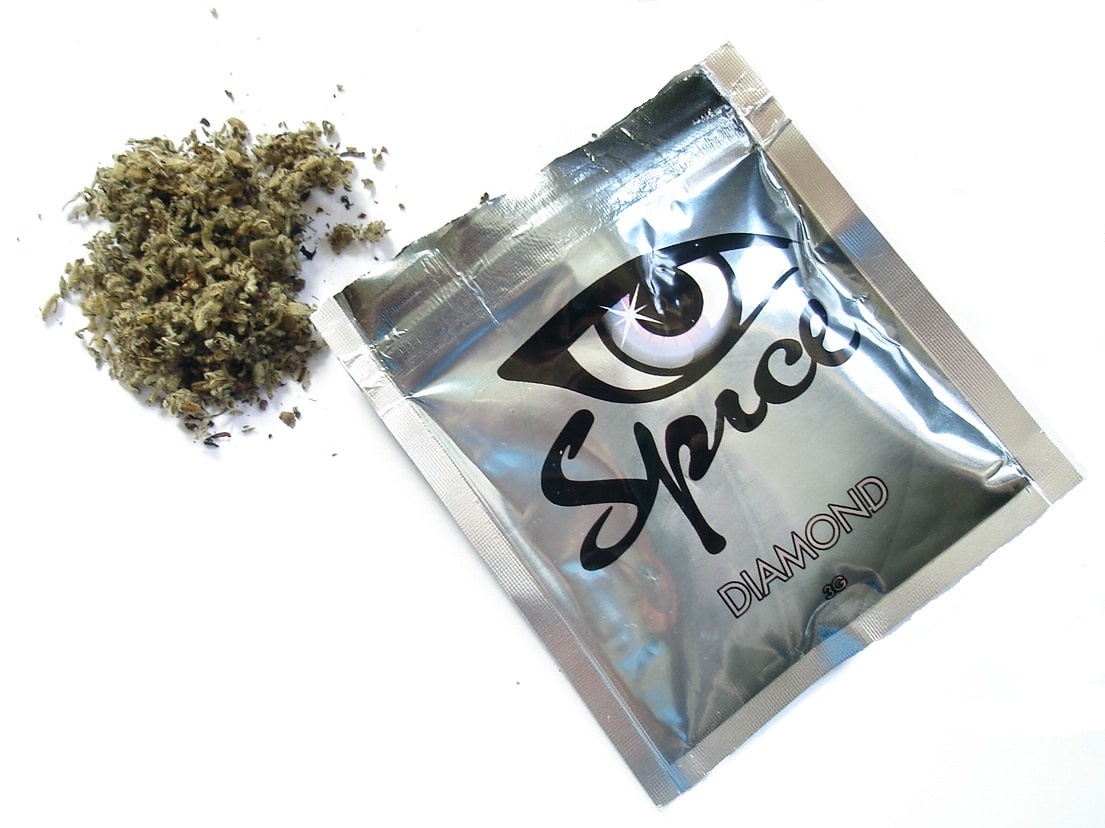Researchers developed synthetic cannabinoids to investigate potential medical applications. But synthetic cannabinoids are now most often sprayed onto herbs then illicitly combusted and inhaled (e.g., spice or K2). [1-4] Manufacturers circumvent illegality with novel cannabinoid formulas given that only some have been identified and outlawed by name. Consumers seek the euphoric effects associated with delta-9-tetrahydrocannabinol (THC) without the risk of failing drug tests. [5]
According to the Centers for Disease Control & Prevention (CDC), “The health effects from using synthetic cannabinoids can be unpredictable and harmful—even life threatening.” Several synthetic cannabinoids have been identified from confiscated samples. In Spain, for example, five patients presented with psychomotor agitation and psychosis; several believed they had superpowers. The patients tested positive for 5F-ADB. [6]
5F-ADB (C20H28FN3O3) was the most common synthetic cannabinoid reported by the Drug Enforcement Administration (DEA) in 2018. It was associated with several motor vehicle deaths in Japan from 2012-2014. [7] Asaoka et al. found that 5F-ADB significantly boosts dopamine via direct agonism of cannabinoid-1 (CB1) receptors. [8] In 2009, Pfizer patented the enantiomer as ADB-FUBINACA for the “treatment of a condition mediated by CB1 receptor activity.” ADB-FUBINACA was linked to death by coronary arterial thrombosis. [9]
The second most seized synthetic cannabinoid in 2018 was also a creation of Pfizer: FUB-AMB, or AMB-FUBINACA (C21H22FN3O3). This cannabinoid was attributed to a “zombielike” outbreak of overdoses in New York and subsequently reported to be 50-85 times more potent than THC. In 2019, it was connected to acute respiratory failure and the subsequent death of a 27-year-old man. [10]
Synthetic cannabinoids are significantly more potent than THC as full (rather than partial) agonists of cannabinoid receptors (esp. CB1 receptors). [11] In other words, they bind completely and powerfully with the receptors of the endocannabinoid system. Metabolites also appear to be more potent and persistent. [12] Overall, potency may range from 2-100 times that of THC. [13] The World Health Organization outlines several potential side effects associated with their consumption:
- Unconsciousness and coma
- Tachycardia
- Chest pain and heart attack
- Seizures
- Psychosis
- Aggressive/violent behavior
- Sudden death
Synthetic cannabinoids are anecdotally associated with more intense withdrawal compared to THC. [14] Although most of the risk is associated with the central nervous system, cardiovascular and metabolic events, acute kidney damage, and respiratory distress are also possible. [13]
Current medical uses for synthetic cannabinoids are very limited: dronabinol (Marinol) is technically synthetic although it is identical to THC. Nabilone (Cesamet) is a synthetic analogue of THC that also acts as a partial agonist. These medications are used to alleviate the nausea of chemotherapy patients.
The magic of THC and cannabis may lie in the old adage, less is more.
References
- Uchiyama, Nahoko, et al. “Chemical Analysis of Synthetic Cannabinoids as Designer Drugs in Herbal Products.” Forensic Science International, vol. 198, no. 1-3, 2010, pp. 31–38., doi:10.1016/j.forsciint.2010.01.004. Journal Impact Factor = 1.947, Times Cited = 194
- Mills, B, et al. “Synthetic Cannabinoids.” Am J Med Sci, vol.350, no.1, 2015, pp.59-62. Journal Impact Factor = 1.962, Times Cited = 63
- Vandrey, Ryan, et al. “A Survey Study to Characterize Use of Spice Products (Synthetic Cannabinoids).” Drug and Alcohol Dependence, vol. 120, no. 1-3, 2012, pp. 238–241., doi:10.1016/j.drugalcdep.2011.07.011. Journal Impact Factor = 3.466, Times Cited = 204
- Diao, Xingxing, and Marilyn A. Huestis. “New Synthetic Cannabinoids Metabolism and Strategies to Best Identify Optimal Marker Metabolites.” Frontiers in Chemistry, vol. 7, 2019, doi:10.3389/fchem.2019.00109. Journal Impact Factor = 3.994, Times Cited = 5
- Ninnemann, Andrew L., et al. “Synthetic Cannabinoids to Avoid Urine Drug Screens: Implications for Contingency Management and Other Treatments for Drug Dependence.” Addictive Behaviors, vol. 63, 2016, pp. 72–73, doi:10.1016/j.addbeh.2016.07.004. Journal Impact Factor = 2.963, Times Cited = 4
- Barceló, Bernardino, et al. “Acute Intoxication Caused by Synthetic Cannabinoids 5F-ADB and MMB-2201: A Case Series.” Forensic Science International, vol. 273, 2017, doi:10.1016/j.forsciint.2017.01.020. Journal Impact Factor = 1.990, Times Cited = 32
- Kaneko, Shuji. “Motor Vehicle Collisions Caused by the ‘Super-Strength’ Synthetic Cannabinoids, MAM-2201, 5F-PB-22, 5F-AB-PINACA, 5F-AMB and 5F-ADB in Japan Experienced from 2012 to 2014.” Forensic Toxicology, vol. 35, no. 2, 2017, pp. 244–251., doi:10.1007/s11419-017-0369-6. Journal Impact Factor = 2.476, Times Cited = 12
- Asaoka, Nozomi, et al. “A New Designer Drug 5F-ADB Activates Midbrain Dopaminergic Neurons but Not Serotonergic Neurons.” The Journal of Toxicological Sciences, vol. 41, no. 6, 2016, pp. 813–816., doi:10.2131/jts.41.813. Journal Impact Factor = 1.732, Times Cited = 8
- Shanks, Kevin G., et al. “Death Associated with the Use of the Synthetic Cannabinoid ADB-FUBINACA.” Journal of Analytical Toxicology, vol. 40, no. 3, 2016, pp. 236–239., doi:10.1093/jat/bkv142. Journal Impact Factor = 2.858, Times Cited = 31
- Adamowicz, Piotr, et al. “Fatal Intoxication with New Synthetic Cannabinoids AMB-FUBINACA and EMB-FUBINACA.” Clinical Toxicology, vol. 57, no. 11, 2019, pp. 1103–1108., doi:10.1080/15563650.2019.1580371. Journal Impact Factor = 4.398, Times Cited = 2
- Banister, Samuel D., et al. “Pharmacology of Valinate and Tert-Leucinate Synthetic Cannabinoids 5F-AMBICA, 5F-AMB, 5F-ADB, AMB-FUBINACA, MDMB-FUBINACA, MDMB-CHMICA, and Their Analogues.” ACS Chemical Neuroscience, vol. 7, no. 9, 2016, pp. 1241–1254., doi:10.1021/acschemneuro.6b00137. Journal Impact Factor = 4.21, Times Cited = 82
- Radominska-Pandya, A., et al. “Synthetic Cannabinoids: Rapidly Emerging Drugs of Abuse.” Pharmacology, vol.31, no.1, 2017.
- Riederer, Anne M., et al. “Acute Poisonings from Synthetic Cannabinoids — 50 U.S. Toxicology Investigators Consortium Registry Sites, 2010–2015.” Morbidity and Mortality Weekly Report, vol. 65, no. 27, 2016, pp. 692–695., doi:10.15585/mmwr.mm6527a2. Journal Impact Factor = 14.874, Times Cited = 22
- Abouchedid, Rachelle, et al. “Acute Toxicity Associated with Use of 5F-Derivations of Synthetic Cannabinoid Receptor Agonists with Analytical Confirmation.” Journal of Medical Toxicology, vol. 12, no. 4, 2016, pp. 396–401., doi:10.1007/s13181-016-0571-7. Times Cited = 9













